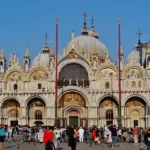
San Agustin Church, located in Intramuros, Manila, Philippines, is a historical and architectural gem that dates back to the 16th century. It is the oldest stone church in the country and is renowned for its Baroque architecture, featuring intricate details and a stunning facade. The church has been designated as a UNESCO World Heritage Site, recognized for its cultural significance and historical value. Inside, visitors can admire beautiful altars, religious artifacts, and a unique wooden ceiling, making it a popular destination for both tourists and locals alike. San Agustin Church serves not only as a place of worship but also as a testament to the rich history of the Philippines.
Construction Start Date: The construction of San Agustin Church began in 1586 under the direction of the Spanish Augustinian friars. This marked a significant moment in Philippine history as it was one of the first stone churches built in the archipelago, symbolizing the spread of Christianity in the region. The early stages of construction utilized local materials and labor, showcasing the integration of indigenous skills and resources in colonial architecture.
Completion Date: The church was completed in 1607, taking over two decades to build. This lengthy construction period was not only due to the scale and complexity of the Baroque design but also because of the challenges posed by the local environment, including natural disasters. The completion of the church established it as a central place of worship and a cornerstone of the Augustinian mission in the Philippines, serving the growing population of Manila.
Architectural Style: San Agustin Church is designed in the Baroque architectural style, characterized by its dramatic use of light and shadow, elaborate ornamentation, and grand scale. The church features a façade that is both imposing and intricate, with its ornate details reflecting the artistic sensibilities of the period. The Baroque style was particularly significant in the Spanish colonial context, as it was used to convey the power and glory of the church and the Spanish Empire.
UNESCO World Heritage Site: In 1993, San Agustin Church was designated a UNESCO World Heritage Site as part of the Baroque Churches of the Philippines. This recognition highlights its cultural significance and architectural value, marking it as one of the most important historical sites in the country. The designation aims to preserve the church for future generations and acknowledges its role in the cultural landscape of the Philippines, representing the fusion of European and local influences.
Materials Used: The construction of San Agustin Church utilized coral stones and bricks, which were sourced locally from the nearby coastal areas. Coral stones were favored for their durability and aesthetic appeal, giving the church its distinctive appearance. The use of these materials not only reflects the architectural practices of the time but also the adaptation of European designs to the local context, showcasing the ingenuity of the builders in overcoming the challenges of the Philippine environment.
Height: The church’s façade stands approximately 25 meters tall, making it one of the most prominent structures in the historic district of Intramuros. This height is not only a testament to the architectural ambition of its builders but also serves a practical purpose, allowing the church to be visible from a distance, thereby attracting worshippers and visitors alike. The grand height adds to the church’s imposing presence, signaling its importance as a center of faith and community.
Length: San Agustin Church measures about 70 meters in length, providing ample space for congregational worship and gatherings. This length accommodates a significant number of parishioners, reflecting the church’s role as a central place of worship in Manila. The spacious interior allows for the celebration of various religious ceremonies, including masses, weddings, and special events, reinforcing the church’s significance in the lives of the local community.
Width: The church has a width of approximately 30 meters, which contributes to its grand and expansive interior. This width allows for a wide nave and side aisles, enhancing the architectural flow and providing a comfortable setting for worshippers. The spaciousness of the church interior is designed to facilitate large gatherings, making it an ideal venue for significant religious events and celebrations that draw large crowds.
Bell Towers: San Agustin Church features two bell towers, one of which stands at 45 meters tall. These bell towers are not only functional, housing the church bells that call the faithful to worship, but also serve as architectural landmarks. The height of the towers enhances the church’s visibility and adds to its grandeur, while the bells themselves are an integral part of the church’s heritage, marking the passage of time and the rhythm of daily life in the community.
Historical Significance: San Agustin Church is recognized as the oldest stone church in the Philippines, a status that underscores its historical importance. It has witnessed numerous pivotal events in Philippine history, including the arrival of Spanish colonizers, the establishment of Christianity, and various socio-political changes over the centuries. The church stands as a testament to the resilience of cultural heritage, having survived natural disasters and wars, and continues to be a symbol of faith and community for many Filipinos.
Earthquake Resistance: San Agustin Church has withstood several earthquakes throughout its history, including the significant earthquake of 1863 that caused widespread destruction in Manila. Its construction utilized strong coral stones and a robust design, which contributed to its resilience. The church’s ability to endure these natural disasters is a testament to the engineering skills of its builders and the careful planning that went into its construction, allowing it to remain a vital place of worship and historical significance.
Interior Design: The interior of San Agustin Church is richly adorned with intricate wood carvings and beautiful paintings, showcasing the artistry of the period. One of the most notable features is the ceiling mural painted by Italian artist Giovanni Battista, which depicts biblical scenes and adds to the church’s spiritual ambiance. The elaborate decorations reflect the Baroque style’s emphasis on grandeur and detail, creating an inspiring environment for worshippers and visitors, and highlighting the cultural exchange between European artists and Filipino artisans.
Altar: The main altar of San Agustin Church is a remarkable example of craftsmanship, made from intricately carved wood that showcases the skill of local artisans. The altar is adorned with ornate details and religious iconography, serving as the focal point of the church’s interior. It plays a crucial role in the liturgical practices of the church, hosting various sacraments and ceremonies. The altar’s design not only serves a functional purpose but also embodies the spiritual significance of the church as a place of worship.
Relics: The church houses several relics, including those of Saint Augustine, after whom the church is named. These relics are significant to the Catholic faith and attract pilgrims and visitors who seek to connect with the spiritual heritage of the church. The presence of these relics enhances the church’s status as a sacred space, providing a tangible link to the history of Christianity in the Philippines and the life of its namesake, who is revered as a Doctor of the Church.
Baptismal Font: The baptismal font in San Agustin Church is made of marble and is considered one of the oldest in the country. This font is significant as it symbolizes the initiation of new members into the Christian faith through the sacrament of baptism. Its historical value lies in its enduring presence since the church’s early years, reflecting the continuity of religious traditions in the Philippines. The font’s design and material also demonstrate the artistry and importance of baptismal rites in the church’s community.
Museum: San Agustin Church has an attached museum that showcases a rich collection of religious artifacts and historical items related to the church’s history and the broader context of Christianity in the Philippines. The museum features vestments, liturgical items, and artworks, providing visitors with insight into the cultural and religious heritage of the church. This educational aspect enhances the visitor experience, allowing for a deeper understanding of the church’s significance and the role it has played in Philippine history.
National Historical Landmark: In 1976, San Agustin Church was declared a National Historical Landmark in recognition of its architectural and historical importance. This designation highlights the church’s role in the cultural landscape of the Philippines and underscores the need for its preservation. As a National Historical Landmark, the church is protected under Philippine law, ensuring that its heritage is maintained for future generations and that its story continues to be told.
Seating Capacity: San Agustin Church can accommodate approximately 1,200 people, making it one of the larger churches in Manila. This capacity is essential for hosting various religious services, including regular masses, weddings, and special events. The spacious interior design allows for a comfortable experience for worshippers, fostering a sense of community and togetherness during congregational gatherings, which has been a vital aspect of the church’s role in the lives of its parishioners.
Filipino Heritage: San Agustin Church reflects a fusion of indigenous Filipino and Spanish colonial influences, evident in its architectural style and decorative elements. This blend represents the cultural exchange that occurred during the colonial period and highlights the adaptation of European designs to local contexts. The church serves as a symbol of Filipino identity and heritage, representing the resilience and creativity of the Filipino people in preserving their cultural and religious traditions.
Significant Events: Over the centuries, San Agustin Church has hosted numerous significant events, including the wedding of former Philippine President Ferdinand Marcos and Imelda Marcos in 1954. Such high-profile ceremonies have cemented the church’s status as a prestigious venue for important life events. The church’s historical significance is further enhanced by its role in various religious and cultural celebrations, making it a central part of the community’s social fabric and a witness to the nation’s history.
Preservation Efforts: San Agustin Church has undergone various restoration efforts, particularly after the devastating 1945 Battle of Manila during World War II, which caused extensive damage to many historical structures in the area. Recognizing the church’s historical and cultural significance, preservation initiatives have focused on restoring its architectural integrity and repairing damage to its interior and exterior. These efforts have included the careful restoration of artwork, structural reinforcements, and the maintenance of its historical features, ensuring that the church remains a vital part of Manila’s heritage.
Cultural Events: San Agustin Church serves as a venue for various cultural and religious events, including the annual Feast of San Agustin, which celebrates the church’s patron saint. This event attracts large crowds and features processions, masses, and other religious activities that showcase the vibrant traditions of the Filipino Catholic community. The church’s role in hosting these events emphasizes its importance not only as a place of worship but also as a center for cultural expression and communal gathering, reinforcing its significance in the lives of the people.
Famous Weddings: The church is a popular venue for weddings and has been the site of many high-profile ceremonies, including those of prominent figures in Philippine society. Its historical ambiance, beautiful architecture, and spiritual significance make it an ideal location for couples seeking a meaningful setting for their nuptials. The tradition of marrying in San Agustin Church is steeped in cultural significance, and many couples choose to celebrate their union in a place that embodies both faith and history, adding to the church’s legacy as a cherished wedding venue.
Visitor Numbers: San Agustin Church attracts thousands of visitors and worshippers annually, both local and international. Its status as a UNESCO World Heritage Site and its historical significance draw tourists interested in exploring the rich cultural heritage of the Philippines. The church serves not only as a place of worship but also as a museum of history and art, where visitors can appreciate its architectural beauty and learn about its storied past. This influx of visitors contributes to the local economy and promotes awareness of the church’s importance in the broader context of Philippine history.
Location: San Agustin Church is located in the historic district of Intramuros, Manila, which is known for its rich colonial history and well-preserved architecture. Intramuros, often referred to as the “Walled City,” was the center of Spanish colonial rule in the Philippines and is home to several other historical landmarks. The church’s location within this historic area enhances its significance, as it stands as a testament to the enduring legacy of Spanish influence in the Philippines. Its accessibility makes it a focal point for both religious activities and cultural tourism, linking the past with the present.
Frequently Asked Questions About San Agustin Church
About the Church
1. What is the significance of San Agustin Church?
- San Agustin Church is the oldest stone church in the Philippines, built in the 16th century. It’s considered a masterpiece of Spanish Baroque architecture and has been designated a UNESCO World Heritage Site.
2. Who built San Agustin Church?
- The church was built by the Augustinian friars, a Catholic religious order.
3. When was San Agustin Church built?
- The construction of San Agustin Church began in 1587 and was completed in 1604.
4. What is the architectural style of San Agustin Church?
- San Agustin Church is primarily in the Spanish Baroque style, characterized by its ornate details, dramatic curves, and use of light and shadow. It also incorporates elements of Chinese and Filipino design.
5. Has San Agustin Church been damaged or restored?
- The church has survived several earthquakes and typhoons, as well as World War II. It underwent major restoration efforts in the 20th century to repair the damage caused by these events.
Visiting San Agustin Church
1. Is there an entrance fee to visit San Agustin Church?
- The church itself is free to visit. However, there may be a fee for admission to the museum or for special events.
2. When is the best time to visit San Agustin Church?
- The church is open to visitors most days of the week, except during special events or religious services. It’s generally less crowded during weekdays and early mornings.
3. What can visitors expect to see at San Agustin Church?
- Visitors can admire the church’s beautiful architecture, including its intricate carvings, frescoes, and gilded altar. They can also explore the museum, which houses religious artifacts and historical exhibits.
4. Are there any restrictions or rules for visitors to follow?
- Visitors are typically expected to dress modestly and to be respectful of the church’s religious significance. Photography may be restricted in certain areas, especially during religious services.
Special Events and Activities
1. Does San Agustin Church host any special events or activities?
- Yes, the church often hosts religious ceremonies, concerts, and cultural events. It’s a popular venue for weddings and other special occasions.
2. Can visitors attend religious services at San Agustin Church?
- Yes, visitors are welcome to attend Mass or other religious services at San Agustin Church. However, it’s important to check the schedule in advance.
3. Are there any guided tours or educational programs available at San Agustin Church?
- Guided tours and educational programs may be available, especially for groups or school visits. It’s best to inquire directly with the church or a local tourism office.
4. Can visitors purchase souvenirs or other items at San Agustin Church?
- There may be a gift shop or souvenir stand located on the church grounds where visitors can purchase items related to San Agustin Church or the Philippines.









